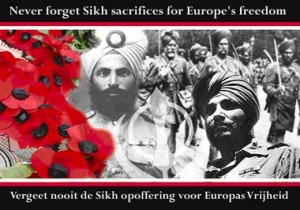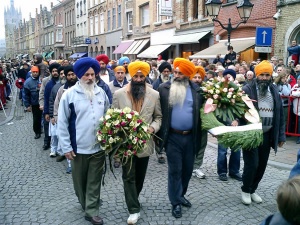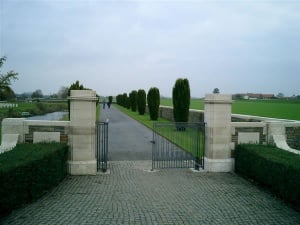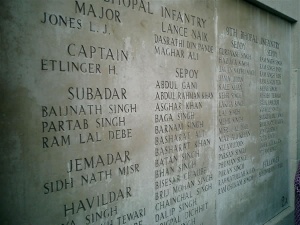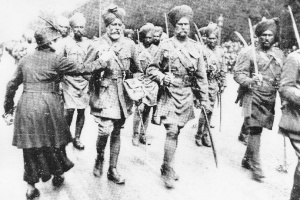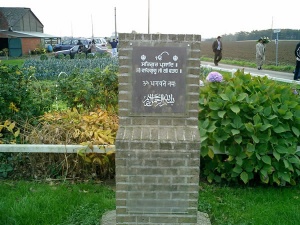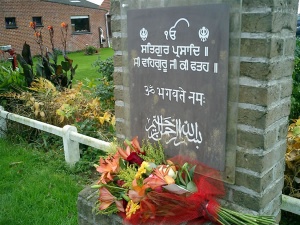Europe remembers
based on articles by Bhupinder Singh Holland and by Johan Meire
During the weekend of 2-4 April 1999, hundreds of Sikhs from Belgium, the Netherlands, France and Britain gathered in the Belgian town of Ypres (Ieper) to combine a celebration of the Vaisakhi and the 300th anniversary of the birth of the Khalsa, with a commemoration of the Indian soldiers who fell in the First World War in the former front zone around Ypres, the so-called Ypres Salient.
This article elaborates on how this event originated, and on how it bound together two very different groups. Beyond doubt, this was one of the most remarkable commemorations of the First World War (1914-1918) that ever took place on this former battlefields. It was a unique event in other ways as well. It was unusual in that Ypres has no Sikh community: why then celebrate Vaisakhi in this small town, while most Belgian Sikhs live at the other end of the country or in Brussels, where they have Gurdwaras of their own?
The Sikh history in the First World War was an almost forgotten past: both for the Sikhs themselves and for the Belgians. One of the remarkable things about the celebration in Ieper was that it revealed this forgotten past. And it did so in many ways: through historical research, an exhibition, and unveiling of the Hollebeke memorial. Distinguished Belgium leaders were presented with siropa (Robe of Honor) and Governor Brijne of Flanders honored a Muslim Mayor from U.K and two members from the Sikh community. The living soldiers of World War II and the family of Havaldar Badan Singh (Gent, Belgium) were honoured. A beautiful plaque written in Dutch-English and Gurmukhi was presented to all participants.
It was not just Sikhs who participated but together with the people of Belgium actually shaped the memorable event. During the celebration of Vaisakhi in Ypres, part of the town’s mediaeval Cloth Hall – completely destroyed during the war and faithfully rebuilt afterwards – was furnished as a Gurdwara and a Langar. Here people of all background met to pay respect for the fallen soldiers.
The celebrations included Akhand Path, Kirtan and the celebration of Vaisakhi proper. They started on Friday morning and came to an end on Sunday in the late afternoon. All these celebrations were open to Sikhs and non-Sikhs alike, and during the weekend many people from the Ypres region visited the temporary gurdwara, listened to kirtan and tried the food in the langar. The usual proceedings of the celebrations of the Vaisakhi – albeit in a unusual place – were complemented by several memorial practices referring to the Sikh and Indian soldiers who fought in the Ypres Salient during the First World War. An exhibition on Sikhism and the role of the Sikhs in the war was mounted.
Sikhs in World Wars
Many Sikh soldiers died in Europe far away from their homes and families while holding firm to their faith, and serving people of a different culture with whom they had not much in common except love for humanity. On Saturday afternoon, there was a guided tour to some places where Sikh soldiers had fought and where they were buried. In the village of Hollebeke, close to Ypres, a little monument was unveiled that commemorated the first actions of Indian troops in the Great War. In the temporary gurdwara, local and Sikh authorities made speeches and exchanged gifts.
Finally, on Saturday and Sunday, special Last Post ceremonies were held, with many Sikhs attending and participating. The Last Post – the traditional (British) salute to the fallen warrior – is sounded every evening under the Menin Gate, a British memorial to the missing in Ypres, to commemorate all soldiers who fell around Ypres. This ‘celebration of peace’, as it was called, was a joint organisation of European Sikh communities and the town of Ypres.
This mutual interest is rather surprising. For instance, not a single Sikh is living in Ypres. Moreover, the contribution of Sikh soldiers during the First World War in the Ypres Salient in 1914 and 1915 had disappeared completely from the social memory and even from the mere knowledge of the Sikhs living in (continental) Europe until about just a year before the commemoration. As the Sikhs look at their history as consisting of an ongoing series of violent episodes, their short if bloody engagements in the First World War only appear to be relatively unimportant incidents.
Conversely, the presence of Indian soldiers in the Ypres Salient was too short for the former Allies to commemorate their contributions or their war dead in a separate memorial. In the former war zone, but also in Britain, Indian soldiers are commemorated in cemeteries, on memorials and in remembrance ceremonies as belonging to the former British Empire.
Sikhs in Britain
In Britain, Sikhs have regularly taken part in commemorations of the war, receiving war medals and so on. However, the interest of European Sikhs in their ‘European’ war history in fact is very recent. In 1998 Sikhs were for the first time invited to lay a wreath at the National War Monument in Amsterdam, on World War Two Liberation Day in Holland. Shortly thereafter, a delegation of European Sikhs visited Ypres for the first time; this part of European and Sikh history was nearly completely unknown until then. Not much later, during a special Last Post under the Menin Gate in Ypres, specific attention was given to the Indian soldiers who fell in the Great War.
The president of the International Sikh Youth Federation, Bhupinder Singh Holland, gave a short speech there in 1998, and it was then that the idea of celebrating Vaisakhi in Ypres originated. A fitting celebration of the 300th anniversary of the birth of the Khalsa would have to refer to accomplishments made in the past, and especially would have to honour the martyrs. As Sardar Bhupinder Singh told me, when he reflected on how to do this, he found that martyrdom in the 20th century was abound for the Sikhs, but that only both World Wars were typical of Europe. This made Ypres a more and more fitting choice.
Further, to celebrate Vaisakhi in a public non-Sikh space, ‘among outsiders’ (non-Sikhs), could be a way to make clear that Sikhs in Europe want to be acknowledged as being part of European societies. At first sight, it might look strange that Sikhs celebrate Vaisakhi in a small provincial town such as Ypres, but it was an appropriate choice. It brought to the fore both the (largely unknown) ‘European’ past and martyrdom of the Sikhs, and at the same time the recognition by outsiders (Belgians) that would help to enhance the self-image of Sikhs in Europe. On Armistice Day (11 November) 1998, a fairly large delegation of Sikhs from Belgium and Holland participated in the ‘poppy parade’, a yearly ceremonial walk from the centre of Ypres up to the Menin Gate.
The Sikhs carried a large banner (“Sikh-Community Gurdwara-Sangat-Sahib St.Truiden Belgium”) and a large wreath (“Sikhs commemorate all the fallen”), that was laid down under the Menin Gate. This shows that the Sikhs wanted to include the First World War in their own history, and that they wanted to be recognised, as Sikhs, for their participation in the war. This, however, were merely Sikhs taking part in a fully ‘western’ commemoration ritual. A mutual fusion of ‘Sikh’ and ‘western’ commemorations occurred on the Vaisakhi weekend in the beginning of April 1999.
To my knowledge, this ‘merging’ was a totally unique event. Such a joint celebration or commemoration does not originate without efforts. Nor is it just a consequence of what happened in the past. As I already noted, most Belgians and Sikhs were virtually unaware of the Indian/Sikh contribution to the First World War. It was rather the other way around: the pending organisation of the ‘celebration of peace’ was a good occasion to do some historical research (e.g. in order to organise an exhibition on the Sikhs, or to locate the exact place of the first action of Indian soldiers, which would be the spot on which a monument would be erected during the weekend).
In this way, what happened in the past provided the commemoration with a certain structural frame: it showed where a monument would be appropriate, or where graves of Indian soldiers could be found. What happened in the past gave authority to the commemorations. However, it was not the past itself, or the historical research, that made these places or commemorations ‘memorable’. This could only be done by actual memory of the events during the weekend of the Vaisakhi in Ypres itself. A joint celebration by Belgian and Sikhs not only requires a historical ground. It also requires that both groups have some things in common: things they consider as important to their own past, and thus to their own identity. It does not require that both groups have to lose their distinctive character; rather, they have to find some common ground.
Martyrdom
While ‘dissonant’, clashing memories of both groups were minimised, a common heritage was stressed. This heritage was: martyrdom. During the First World War, the city of Ypres was totally destroyed. The symbol of this destruction was the mediaeval Cloth Hall, which was rebuilt afterwards. In this building, where the temporary Gurdwara was set up, the In Flanders Fields Museum can be found: Ypres’ impressive war museum. At the entrance of the museum, which was also next to the entrance of the Gurdwara, on a big stone the names of many ‘martyred cities’ are engraved, such as Hiroshima, Dresden or Sarajevo.
Ypres considers itself as a martyred town, a symbol of the destruction and suffering war brings about. To honour the martyrs is a well-known aim of Vaisaikhi, and during the celebration in Ypres, this aim was made quite clear to (non-Sikh) visitors, however without turning martyrdom and the present oppression in India into political issues. One of the Sikh speakers at the Vasaikhi said: “The Sikhs have done their prayer for victory and for martyrdom. They have got both. They have got victory and they have got martyrdom in Ypres.” As made clear by the exhibition on the Sikhs in the Great War, the erection of a monument to the Indian soldiers, and the guided tour in the former war zone, Ypres and the Sikhs had a heritage in common: “the common history we share, which is the destruction in war, the martyrdom in war”, like it was expressed by Piet Chielens, co-ordinator of the In Flanders Fields Museum. Mutual memories were stressed; at the same time, some differences between Belgians and Sikhs that could create unease or could make a joint celebration difficult, were minimised or ‘forgotten’.
Sikh soldiers and the locals
During the war, soldiers often were not really loved by the local inhabitants of the front zone (such as Ypres), and the feelings of distrust were especially apparent towards the colonial troops, like Senegalese, Moroccans, Indians and Chinese. Girls and women were warned to keep away from them, and local inhabitants were very curious to find out which strange habits these exotic soldiers had. For instance, the food and smoking habits of Indian soldiers (often just called ‘hindoos’) attracted much attention. Surely, there was friendly contact between Indian soldiers and local people, but like other non-European soldiers, Indian soldiers were often considered as wild and cruel warriors, and at the same time as childish, distrusting, curious, sneaky and unreliable. This distrust was, of course, not brought back into memory during the Vaisakhi in Ypres: in his speech, the governor of the province of West-Flanders (in which Ypres is situated) even claimed that openness and hospitality “have always been typical of our province”.
The Sikhs also had to get rid of a possibly awkward matter: while the Vaisakhi in Ypres was announced as ‘a celebration of peace’, the Sikhs are considered as a people with a strong martial tradition, and also are proud of their tradition of ‘warrior saints’. While the initiation in the Khalsa also implies a military duty and there should be no opposition between sanctity and military prowess, to non-Sikhs this could seem quite a contradiction. For instance, the lesson Ypres wants to learn from its own war experience, is to avoid war at any cost. Therefore, during the celebration in Ypres, Sikh participants did not put stress on warrior values, but on martyrdom. Moreover, Sikh speakers made use of a very universalistic discourse: again and again they repeated that they wanted to commemorate all Indian soldiers, Muslims and Hindus included.
Vaisakhi 1999
During the Vaisakhi in 1999, the war in Kosovo was raging: it is obvious that, within this context, and during ‘a celebration of peace’, an openly ‘ethnic’ discourse would be counter-productive. Just like finding a historical ‘ground’ for the joint commemoration, the mutual attuning of memories was a precondition to it. Its essence, however, lay in joint memory practices. During the reading of the Guru Granth Sahib, two coaches guided interested Sikhs and Belgians through the Ypres Salient; during this trip, a monument was unveiled in the village of Hollebeke.
The simple ceremony included speeches by Belgian and British authorities (a.o. mayors from Indian origin) and an Indian veteran from World War Two. After that, Panj Piaras unveiled the monument, and the Sikhs present sang a jubilation song to honour God and the martyrs. Despite the heavy rain at this point, many Sikhs took photographs of the unveiled monument. The small monument, made of the light yellow brick typical of this region, includes verses in Gurmukhi, Hindi and Urdu texts from the Guru Granth Sahib, the Gita (Hindu text) and the Koran.
In Dutch and in English, it also mentions: "On this spot, on October 26, 1914, troops of the Indian Army were deployed in World War One for the first time, when they engaged in battle on the line Hollebeke – Wijtschate – Mesen. This monument was inaugurated on April 3, 1999 by Punj Piaras to commemorate all soldiers of the Indian Army who died in Belgium between 1914 and 1918." The monument thus commemorates a historical moment, all Indians fallen in Belgium in the Great War, and the inauguration of the monument itself. The monument materially includes the Sikhs in the memory of the war in the Ypres Salient: it gives them a proper place of their own, rather than being defined as former citizens of the British Empire.
Reversibly, the monument inscribes Ypres and Hollebeke, and the First World War, in the social memory of the European Sikhs. It is inaugurated by punj piaras, recognised by the Belgian authorities, and symbolically appropriated by the song at the end of the ceremony. Since 1999, a delegation of Sikhs visits the monument after participating in the yearly commemorations on Armistice Day (November 11) in Ypres. The same song mentioned above also played a major, though unexpected role in the special Last Post ceremonies that were held under the Menin Gate in Ypres on Saturday and Sunday. Hundreds of people attended this ceremony, which included – as usual, on special occasions – the playing of the Last Post melody, the laying of wreaths, the recitation of Binyon’s poem ‘They shall not grow old’, and on minute of silence.
To the surprise of the local persons present, the Sikhs started singing their impressive tribute to God and the martyrs, strikingly resonating under the arch of the Menin Gate. On Sunday, this ceremony brought the celebration of Vaisakhi to an end; it was preceded by a Nagar Kirtan (including Nishan Sahib, and punj piaras reciting “Sat Naam Waheguru”, though without the Granth Sahib), leading from the gurdwara in the Cloth Hall up to the Menin Gate. As can be seen, ‘western’ and ‘Sikh’ memorial practices existed side by side during these celebrations. But even more happened: they also mutually fused, and they created a memory not ‘of the Sikhs’ or ‘belonging to the Belgians’, but a blended, hybrid memory. For instance, the Cloth Hall, symbol of destruction in war, at the same time ‘became’ a gurdwara by the presence of Sikhs and their religious practices. In this way, and by the commemorations in Hollebeke and under the Menin Gate, the Vaisakhi, a religious celebration, also become a war commemoration. Because of this, the Vaisakhi in Ypres was very explicitly open to outsiders: in this way, non-Sikh onlookers also became participants.
Monument
The unveiling of the monument, the Last Post and the speeches during Vaisakhi were done by both Belgians and Sikhs. The monument is as much Sikh (unveiled by punj piaras, commemoration of Indian fallen, Punjabi text) as it is western/Belgian (brick stone, standing in Hollebeke, Dutch and English texts). This monuments interweaves Belgian and Sikh memories. Even though it was unveiled by Belgians and by Sikhs, and even though these Sikhs were coming from different countries and are living in a diaspora, the unveiling ceremony created a specific, local place which is ‘of Sikhs and Belgians together’.
The same is true for the Last Post ceremony, which usually is a western ritual, but by adding the jubilation song, the emotional impact of the Last Post during the Vaisakhi weekend was changed and enhanced greatly – both for Belgians and for Sikhs. What the Vaisakhi-weekend in Ypres did, was to bring together two very different groups, to create a new ‘community of memory’. Even though this community was based on events happening in the past, and even though the link between past and present was made tangible by the presence of the daughter and three grandchildren of hawaldar (sergeant) Badan Singh Mangat, veteran of 1914-1918, the bond between Belgians and Sikhs was actually created by the memory practices during the weekend itself. Piet Chielens, co-ordinator of the In Flanders Fields Museum, said it like this during Vaisakhi: “What we have done in the last three days is creating another tie, another knot, which cannot be undone.”
The monument in Hollebeke, and the many gifts that were exchanged on the occasion, were the material expressions of the tie. I would like to end this article by highlighting the importance of ‘being together’ in these kinds of complex commemorative events. Remembering the past is not just about ‘thinking of what happened in the past’. This commemoration only worked because Belgian and Sikh participants did things together, for instance by unveiling a monument together – in the pouring rain, as it happened! It was extremely important that the gurdwara was open to everybody, and that Sikhs and non-Sikhs were treated in the same way. Belgians could visit the gurdwara, listen to kirtan, go to the langar, and even receive karah parshad. Even though this had nothing to do with the commemoration of the war as such, it was tremendously important.
Exchanging gifts and eating together are, in all cultures, most fundamental ways of relating to each other, and in this context it was not even clear who was ‘host’ and ‘guest’: these roles were interwoven during the celebration in Ypres. Only a whole atmosphere of commemorative and other acts, speeches and the material environment could make this complex commemoration and celebration a success: unique as it was, to the participants this commemoration was no longer ‘exotic’ but full of meaning.
sikh armymen names who laid their lives based on cemetriies of world wars courtsey:sikhspectrum site
Quote
"In the last two world wars, 83,005 turban-wearing Sikh soldiers were killed and 109,045 were wounded for the freedom of Britain and the world enduring shell fire, with no other protection but the turban, the symbol of their faith'" General Sir Frank Messervy, KCSI, KBE, CB, DSO. From the forward of Colonel F.T. Birdwood OBE, The Sikh Regiment in the Second World War.
